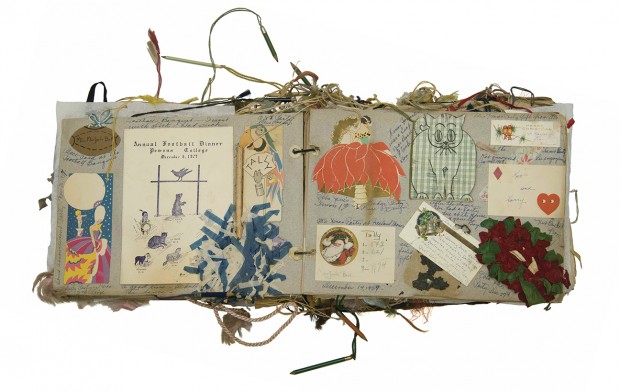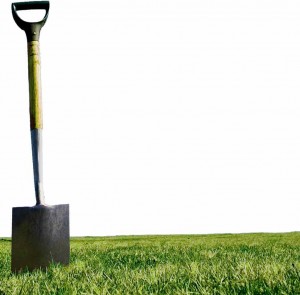 Drought is changing the face of Southern California, as more and more green lawns give way to desert plantings requiring a fraction of the water. At Pomona, turf removal hit a new high this summer, with the replacement of an additional 140,000 square feet (3.4 acres) of grass, according to Head of Grounds Kevin Quanstrom. Among the swaths of grass to be removed were areas around Alexander, Oldenborg, Hahn and Wig halls. Grass-lovers can take heart, however, that the broad, grassy lawn of Marston Quadrangle will remain green—at least for now.
Drought is changing the face of Southern California, as more and more green lawns give way to desert plantings requiring a fraction of the water. At Pomona, turf removal hit a new high this summer, with the replacement of an additional 140,000 square feet (3.4 acres) of grass, according to Head of Grounds Kevin Quanstrom. Among the swaths of grass to be removed were areas around Alexander, Oldenborg, Hahn and Wig halls. Grass-lovers can take heart, however, that the broad, grassy lawn of Marston Quadrangle will remain green—at least for now.
Articles Written By: emae2021@pomona.edu
Turf Wars
Cathedral Song
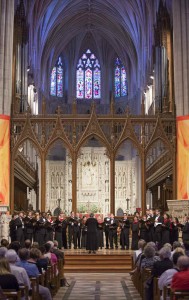 The spring tour of the Pomona College Glee Club took them to a range of performance spaces, from a high school gymnasium in New York’s Washington Heights to a retirement community in Stamford, Conn., to the Church of the Holy Trinity in Philadelphia. However, the undisputed highlight of the tour was a half-hour concert in the National Cathedral in Washington, D.C.
The spring tour of the Pomona College Glee Club took them to a range of performance spaces, from a high school gymnasium in New York’s Washington Heights to a retirement community in Stamford, Conn., to the Church of the Holy Trinity in Philadelphia. However, the undisputed highlight of the tour was a half-hour concert in the National Cathedral in Washington, D.C.
“To sing music in a space that is like what the composer thought about really brings the music to life in a way that we can’t recreate here on campus,” says conductor and Professor of Music Donna Di Grazia. “From an educational perspective as well as an artistic one—those things go hand in hand—there’s nothing like that experience for our students. … And then you also get to give this gift of music to those who come.”
Founders Day and the New Millikan
Save the Date: October 3, 2015
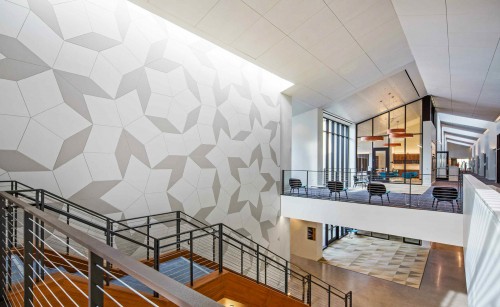
The focus will be on the wonders of physics, astronomy and mathematics during Pomona’s 2015 Founders Day, which will feature the official opening of the beautiful new Millikan Laboratory and the renovated Andrew Science Hall. The dedication ceremony is set to begin at 1:30 p.m., and to be followed by a range of interactive science and math activities for all age groups throughout the afternoon, ending around 7 p.m. Food trucks will be available for dinner from 4:30 to 6:30 p.m. The event is free and open to the public.
2019’s Got Class
Here are just a few of the many interesting and unique individual accomplishments reported by members of the admitted Class of 2019:
- One auditioned and was cast in a small role in the movie The Hunger Games (2012).
- One authored a neuroscience textbook in 11th grade: A Friendly Guide To The Adolescent Brain.
- One wrote five Apple Apps, which achieved 1,000,000 total downloads.
- One has written four full-length novels.
- One is a sous chef for a Michelin-starred restaurant.
- One is a master bee-keeper, the youngest in the state.
Eclectic Electives
Dance, Ethnicity and Nationalism looks at dance as a vehicle for achieving political goals and establishing ethnic identities. Students study such examples as Irish step dancing, Ukrainian and Russian folk dancing and the Hawaiian hula, all of which have served past regimes. Instructor: Anthony Shay
Disease, Destruction, & Disaster examines disaster as a social phenomenon and trends in managing and responding to threats and catastrophe. Students look at such case studies as Hurricane Katrina, Fuku-shima and the Ebola outbreaks. Instructor: Brady Potts
Drone Theory focuses on the drone as part of a network of ubiquitous, always-active sensors for automated data collection, processing and response. Looking at the drone through critical media theory, students think about asymmetrical power and remote control, and the historic relationship between military and media technology. Instructor: Mark Andrejevic
Edible Elements
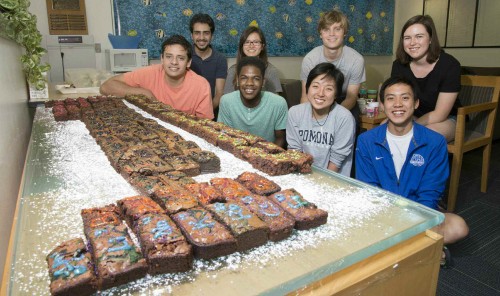
Each summer, the students working in Chemistry Professor Mal Johal’s research lab take a break from their work on ultra-thin assemblies to create a dessert version of the periodic table for one of their weekly barbecues. Past efforts have included cookies and cakes—this year, it was brownies, complete with rainbow sprinkles for the radioactive elements. Posing with their creation are: (from left, front row) Carlos Hernandez ’18, Devin Gladys ’17, Zi-Chen Liu ’18, Samuel To ’18, (back row) Kavoos Kolahdouzan ’18, Vanessa Machuca ’18, Conner Kummerlowe ’16 and Hannah Wayment-Steele ’15.
Have a Jolly Holi
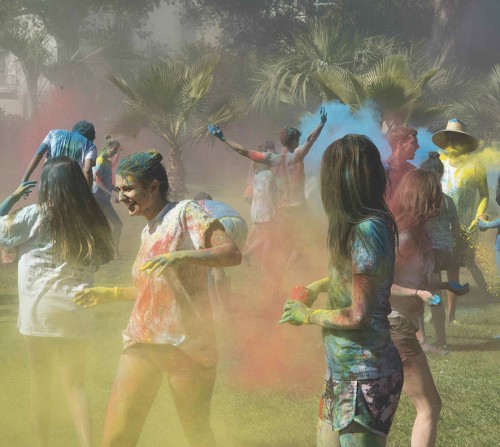
Since 2000, Walker Beach has been the site of The Claremont Colleges’ increasingly popular celebration of Holi, the springtime festival of colors and love that originated in India. Organized by the Claremont Hindu Society, with the support of the Office of Chaplains, the festival is celebrated as a carnival of bright colors, with participants throwing dry colored powder or colored water at each other until both crowd and surroundings appear to have been tie-dyed. Last March, more than 400 students from across the campuses took part in the 2015 festivities.
Under Prometheus
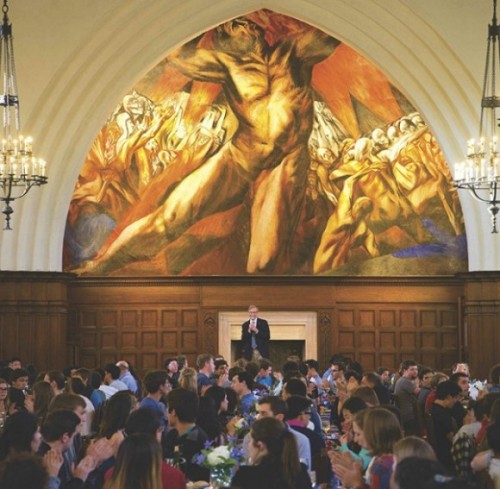
President David Oxtoby welcomes the members of the Class of 2015 to a Senior Dinner on April 7 beneath José Clemente Orozco’s fresco of Prometheus in Frary Hall.
Stories Matter
STORIES MAKE us better.
That’s not just my opinion as a writer and editor who’s made a living telling stories for many years. It’s my opinion as a human being who, like all human beings, depends on stories to keep his heart fresh and alive.
Stories can be magical things. They have the power to break down walls, blunt prejudices, calm fears, alter points of view. As I write this, the news just came in that the Supreme Court has come down on the side of gay marriage, following a veritable tidal shift in American public opinion on the subject, following lots and lots of stories—individual stories—that slowly filtered into people’s hearts.
As human beings, we’re simply not geared to sympathize with groups of people, especially groups that are, in some seemingly significant way, different from ourselves. In fact, the opposite may well be true. We fear the collective other. We eye them with suspicion and jealousy. We create stereotypes to rationalize our fears. Some of this may even be written into the darkest corners of our genes.
Statistics—the ultimate in thinking about human beings as collectives—can bring an informative bit of reality into play, and they may nudge us intellectually in a new direction, but they don’t touch our emotions. As someone once said, a million deaths is a statistic, but one death is a tragedy.
That’s because we are also wired to feel empathy—not for groups, but for individuals. We do this largely through the stories we’re told and the stories we tell ourselves about our own experiences.
Literature, I remember reading long ago, is about the creation of complex sympathies. I’ve always liked that definition. Not simple sympathies—those are too easy. It’s easy to empathize with people very much like ourselves, especially if they’ve been victimized or unjustly accused or if they’ve been thwarted by no clear fault of their own.
It gets harder, however, when it’s someone we don’t quite understand, someone whose actions or motivations or origins go against the grain of our opinions or prejudices. It gets harder still when it’s someone from a group we actively disapprove of, someone we automatically stereotype, someone we view with suspicion or fear.
That’s why stories are so important. Good stories are subversive—they intrude upon our neatly built theories with humane sympathies. They put human faces on our straw men. They’re the bulldozers in our heads that make room for growth.
The theme of this issue, “Untold Stories” might be said to be an oxymoron. After all, isn’t a story by definition something that’s told? But there are so many stories—potential stories anyway—that for one reason or another we never hear. Sometimes they’re untold because of fear or embarrassment. Sometimes because of the walls we build to keep them in. Getting them out into the open is sometimes essential therapy for those who have been keeping them inside, but it’s also good therapy for those of us who need to hear them in order to expand our own capacity for complex and humane sympathies.
—MW
88 Years Ago
ITEM: The Marjorie Maude Bell ’28 Scrapbook
DATE: 1924–1928
COLLECTION: One of 37 scrapbooks currently in the Pomona College Archives collection, ranging from the Class of 1901 to the Class of 1972.
DESCRIPTION: 240-page scrapbook (12” X 9” X 6”), jammed with pasted-in invitations, dance cards with attached pencils, tickets, programs, clippings and other memorabilia from Southern California college life in the 1920s.
ORIGIN: The scrapbook was donated by Karen McDaniel, Ms.Bell’s niece, who explained: “She graduated in 1928, and her brother Gilbert Clyde Bell, (my grandfather) graduatedin 1927. She was a very involved student: secretary of her senior class, president of Phi Kappa Sigma literary society,sorority sister of Alpha Chi Omega, among other positions.”
If you have an item from Pomona’s history that you’d like tosee preserved in the Archives, please call 909-621-8138.
